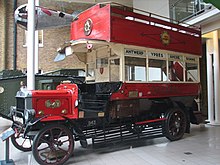LGOC B-type
| LGOC B-type | |
|---|---|
 B340, owned by the London Transport Museum; London to Brighton Run, 2006 | |
| Overview | |
| Manufacturer | London General Omnibus Company |
| Body and chassis | |
| Doors | 1 door |
| Floor type | Step entrance |
The LGOC B-type is a model of double-decker bus that was introduced in London in 1910. It was both built and operated by the London General Omnibus Company (LGOC).
Design and pre-war service
B-type buses were built in Walthamstow and replaced the X-type bus. It had a 34-seat capacity and is often considered to be the first mass-produced bus.[1] The first bus began carrying passengers in 1911.[2][3] By 1913 over 2500 had been built.[3]
The B-type was designed by Frank Searle, who was chief engineer of the LGOC. It had a wooden frame, steel wheels, a worm drive and chain gearbox. Its top speed was 16 miles per hour (26 km/h), which was above the legal speed limit at that time of 12 miles per hour (19 km/h). However the vehicle could reach 30–35 miles per hour (48–56 km/h) under the right conditions.[4]
B-types carried 16 passengers inside and had seats for 18 on the uncovered top deck. These outside seats were fitted with wet-weather canvas covers. Electric lighting was introduced from 1912, and headlights in 1913. Before this, it was thought that interior lighting would render the bus sufficiently visible at night.[4]
World War I service
A total of 900 of the buses were used to move troops behind the lines during World War I.[2] After initially serving without any modifications and in their red-and-white livery, they were painted khaki.[2] It was soon found that the glass windows on the lower deck were prone to breakage, mostly from contact with the men's rifles and packs. The glass was therefore removed and replaced by planks nailed to the sides of the vehicle.[5] Others were converted to lorries or vans, with the bus bodies being placed in storage. [6]
The B-Type could carry 24 fully equipped infantrymen and their kit. Some were converted into mobile pigeon lofts to house the pigeons used for communication along the front.[4] They served until the end of the war when they were used to bring troops home.[2]
Ole Bill


If you know of a better ‘ole . .
The Imperial War Museum preserves a B-Type bus, B43, which was built by AEC in 1911 and ran on London bus routes until being purchased by the War Office in 1914.[7] B43 served in France and Belgium until 1919 when it was repurchased by the LGOC. On 14 February 1920 B43 was inspected by King George V at Buckingham Palace, becoming the first bus any British monarch had ever boarded.[7][6][nb 1] During the early 1920s the bus was retired from service and preserved by the Auxiliary Omnibus Companies Association, who renamed it Ole Bill after Bruce Bairnsfather's celebrated caricature of a British soldier.[7] Ole Bill continued to appear in commemorative parades,[nb 2] before being presented to the Imperial War Museum in April 1970.[11]
Post war
In 1920 more than 60 buses were converted to single deckers with new bodies based on that of the K-type.[12] The last double decker was withdrawn from regular service on 12 October 1926, though a few were held in reserve until 9 August 1927. The single deckers were all withdrawn by 18 October 1927. In all, over 2,900 had been built.[13]
Gallery
- British troops boarding "B types" following the Battle of Arras (May 1917)
- As mobile pigeon loft in WWI
See also
Notes
References
- ^ "B-type LGOC open top motor bus bonnet No B340 registration mark LA9928, 1911". Retrieved 23 May 2018.
- ^ a b c d Livesey, Jack (2007). Armoured Fighting Vehicles of World Wars I and II. Southwater. p. 84. ISBN 978-1-84476-370-2.
- ^ a b Ward, Rod (2007). AEC Album Part One: to 1945. Zeteo Publishing. p. 7. OCLC 1014414977.
- ^ a b c "Exploring 20th Century London - Buses". Museum of London. Retrieved 30 May 2008.
- ^ Destination Western Front: London's Omnibuses Go To War. R. Larkin, 2010. ISBN 978 0 956501400
- ^ a b Ward, 2007, p.9
- ^ a b c Imperial War Museum (2012). "AEC B Type Bus (B43 Old Bill)". Imperial War Museum Collections Search. Retrieved 18 February 2012.
- ^ "Old Bill - King Inspects Bus". www.britishpathe.com. British Pathé. 1920. Retrieved 15 August 2012.
- ^ "Steadily... Shoulder To Shoulder". www.britishpathe.com. British Pathé. 1930. Retrieved 15 August 2012.
- ^ "Old Bill AKA Historic Transport". www.britishpathe.com. British Pathé. 1960. Retrieved 15 August 2012.
- ^ "Ole Bill Bus". Imperial War Museum: Your History. Archived from the original on 13 December 2013. Retrieved 15 August 2012.
- ^ Taylor, Sheila, ed. (2001). The Moving Metropolis. London: Lawrence King Publishing. p. 125. ISBN 1 85669 326 0.
- ^ Lee, Charles E (1974). The Early Motor Bus. Westminster: London Transport. p. 25.
Further reading
- Thackray, Brian (2001). The AEC Story:Part 1. Venture Publications Ltd. ISBN 1-898432-37-6
- Thackray, Brian (2004). AEC Vehicles: Origins to 1929. Venture Publications Ltd. ISBN 1-898432-44-9
- Townsin, A. A. (1980). Blue Triangle. Transport Publishing Company. ISBN 0-903839-34-2
- Robbins, G.J., & Atkinson, J.B. The London B-Type Motor Omnibus, 1970
- Bruce, J.G. & Curtis, C.H. The London Motor Bus, London Transport, 1973. ISBN 0-85329-036-9


